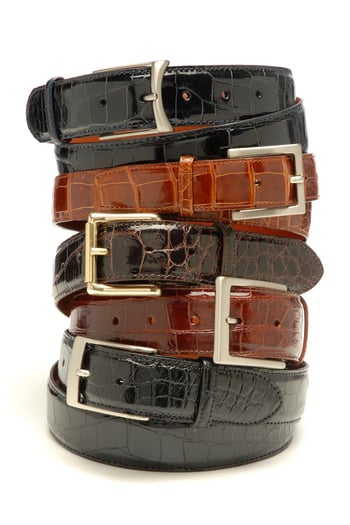Leather belts are typically made out of cattle hide, but can also be made out of other animal skins. When they’re constructed of crocodile or alligator skin, it noticeably adds a touch of style to the outfit.
On the manufacturing end, it can be a tricky process to make belts smooth, durable and stylish. In this post, we’ll give you some pointers to see make sure your next alligator skin belt project is all of those.

Size of the Alligator Skin
One of the more common misconceptions of alligator belt making is that they’re composed of long, singular strips. This is not true. In actuality, the they’re made of several long strips that are combined by intricately-trained artisans.
One may ask, why are they made of several and not just one strip? Well, using only one strip of alligator leather will at most yield you two belts per skin — regardless of how big or neat the cut of the skin is.
Furthermore, having a singular strip of skin would mean the belt would have both belly scales and tail scales. The problem with this is that, aesthetically, it doesn’t look good and shows the mark of an inexperienced craftsman who mixes scale patterns carelessly.
For this reason, using more than one strip of an alligator for your belt crafting is a more aesthetically-pleasing method to ensure a high-quality belt.
Determining the Right Alligator Skin
Rather than looking for the finest skin to make a high-quality belt, you want to look for something different when searching for your materials. It’s advised that leather artisans use big, low-grade skins to garner the most optimum yields. One of the best benefits of using large, low-grade skins is that one is able to avoid defects from being a distraction as multiple strips allows you to cut around the leather’s imperfections if the skin is big enough.
As a rule of thumb, it’s recommended to use grade 4 skins that are longer than 45 cm. Wider belts (wider than 35mm) can utilize skins that are up to 70 cm long. On the other hand, belts that are slimmer (30 mm width or less) cannot use long skins like this as it will distort the look of the large scales.
Cutting Techniques
When taking skin from the alligator’s or crocodile’s midsection and head (the belly and flanks), the strips are cut horizontally and are often used together due to the similarities in the scales’ patterns.
When the skins are large enough, the flanks of the skin can be grouped by themselves. When cut vertically, their unique circular scales can even make belts all on their own. The tails should be cut vertically along the length of the skin and are never mixed with the other areas of the alligator or crocodile.
In summary, using an alligator skin or crocodile skin for your leather belt projects is a great upgrade alternative to traditional cowhide, but does require some special treatment to ensure a job well done. From the size of the skin to determining which area of the alligator or crocodile to choose from, many aspects have to be taken into account to make sure you provide the highest quality product to satisfy your customers.



